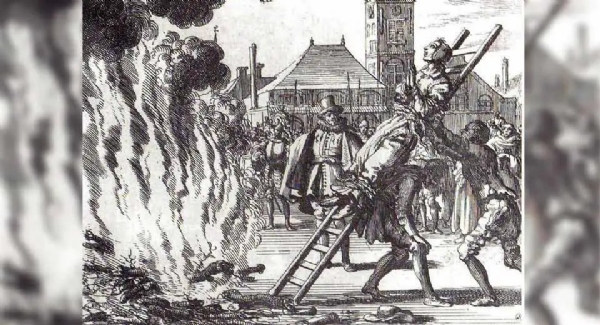The Unnerving Struggle to Remain A Hindu - III
04 Nov 2024 10:08:19
Christianity is a monotheist religion, it believes in One God, One Church, One Prophet, and One Holy Testament. History is replete with examples of its followers' intolerance of other faiths '. Portugese targetting the holy scriptures in Goa was not surprising. The recommendation by the first provincial council made it evident,' Hindus shall not preserve their scriptures '. ( Council organised in 1567 ) All the non-Catholics were compelled to submit the holy books or any object they respected at the customs gate on their return from the pilgrimage to be burnt immediately. This suggestion was accepted and notified as an official order. On violation, rigorous punishment was awarded.

New converts were used to hunt scriptures and other articles. Palm leaves inscribed with mantras or scriptures were tried to be saved. Many learned all by heart to preserve them in case of being confiscated. The scriptures which were found were destroyed. Vaishnav mutt of Madgao ( known as Mutt gram then ) had a great treasure of scriptures, the Vicar collected all the Sanskrit books and set them on fire. ( He didn't know the language in any case) Shri Narayan Tirtha Swami had memorised all the scriptures, thus they could be preserved. He later shifted his mutt to Bhatkal, which is a part of Karnataka state. Years after his successor returned to Goa and established the mutt, which is known as Gokarna Mutt.
This is how Vedas too were preserved. This typical Bharatiya tradition saved the treasure of knowledge for centuries. The knowledge was handed over to the next generations unadulterated. This probably was never understood by the European rulers.
Bharatiya tradition treated the knowledge acquired to be more important than the book or scriptures. Philosophy could not be destroyed by burning the holy scriptures.
Even the temples they razed to the ground were built outside the territory of Portugese. Mantras kept being chanted in homes. To counter this Portuguese rulers decided to convert Brahmins who offered priestly duties and those who did not relent, were to be driven out and their belongings were to be confiscated.
Afonso de Melo, the governor wrote to the King and suggested that those who don't give in to conversion, need to be invited to Portugal and kept away from Goa for some time. They can be compelled to change their faith. In their absence, the administration can convert a bigger number of people.
The attempt to keep people away from the soil did not succeed. Appointment of neo-converts on the administration posts too did not get the desired result of converting a larger number of people.
Miguel Vaz, the Vicar ( pastor ) general visited the king with a scheme to convert people concentrating on 41 steps. He too blamed Brahmins who resented Christianity and deterred fellow countrymen from accepting Christianity. The vicar wanted them to be driven out of Portugese-ruled Goa.
The king translated it into a law, which prevented Brahmins from the recitation of scriptures and any religious preaching in the Portugese-ruled territory. Of course, this too did not yield the desired results. Francis Xavier thought that this class creates confusion among the people (especially Neo-converts, he labelled them as a threat to conversion. He wanted people to understand and participate wholeheartedly in the process of submission to Jesus. He probably comprehended that only laws can make conversion easy. He kept driving the Brahmins out. Some 15 years later in 1560, Constantino de Braganza, the viceroy passed an order which stated that within a month, Brahmins had to leave the territory on their own. Their property was to be confiscated after the time given. It was to be awarded to people who passed on important information and the rest was to be used by the viceroy. Similarly, goldsmiths were ordered to leave the territory and worked on the orders by Brahmins for the deities of the temples outside the Portuguese territory. Many migrated, along with Brahmins, the people working with them too left. Gomantak had to embrace the uncertain future. They travelled to present Karnataka and Kerala cost line. With their departure, the local economy was worst hit,so in 1561 the order was to be annulled. All were requested to return and they were promised to get lands and houses they possessed. Again in 1563, the same order resurfaced, the viceroy along with church administration prepared the list and schedule to drive it all out. This was applied to all the people who were in some or other way related to religious activities. Even kazis were included in the list. Those who failed to follow the dictates were to be arrested and punished suitably. This time people who left, included Kunbis, Vaniyas and Goldsmiths. They moved out confidently. They all cooperated. Those who stayed back used to cross the river to conduct religious rites.
Sometimes one feels how the strange and inhuman conditions were laid down, like refusing the use of palanquins ( palkhi) or chairs by learned men and medical practitioners. The penalty was implemented for not following them.
Hindus could not hold a government job or any position.
In spite of all such illogical dictates, there was not much success. Even neo- converts too could not completely abandon their old faith. Celebrations and participation in religious rites could not be stopped.
So the customs officers in charge of waterways were asked to stop allowing such people from the outside. The right of punishment was with religious authority. ( Fortunately ) Nothing could succeed.